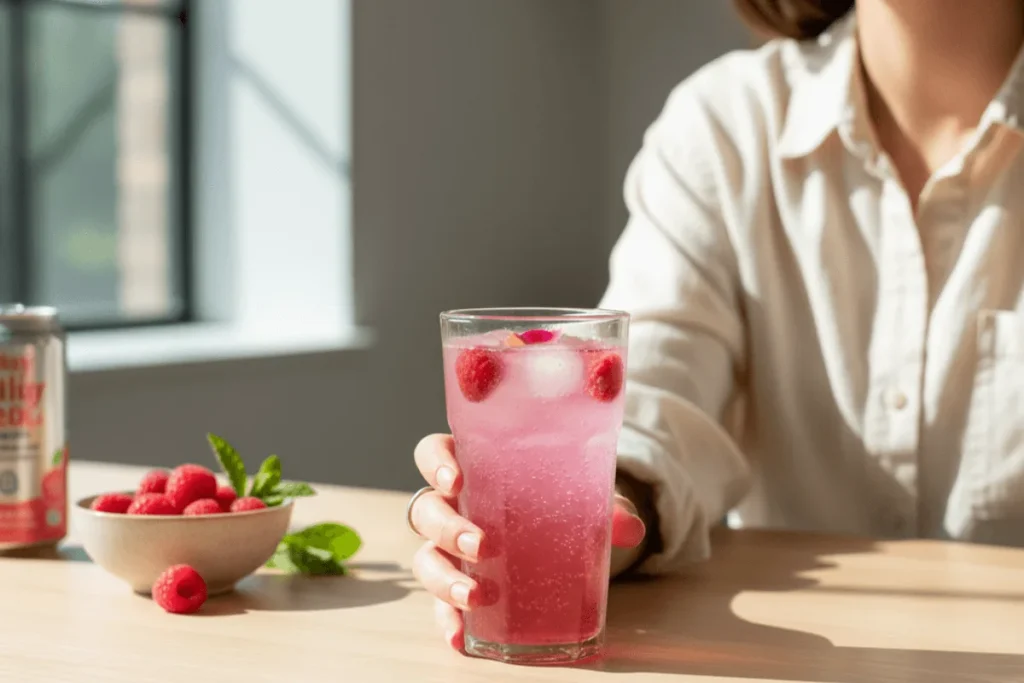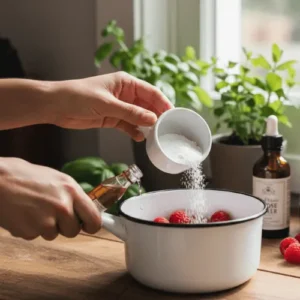Soda is cool again, but this time, it’s the healthy kind. This whole prebiotic soda trend is blowing up the market, finally giving us a legitimate, delicious alternative to those super-sugary classic soft drinks. My fridge is officially stocked with what I’m now calling “gut-friendly fizz.”
Table of Contents
Why the sudden obsession? Because everyone has realized that their gut microbiome (that’s the tiny universe living in your tummy) actually controls their body, influencing everything from digestion to how much energy they have. We all want drinks that work as hard as we do, right?
The experts—aka the genius brands like Olipop and Poppi—have figured out how to make a drink that tastes nostalgic and makes your tummy feel good. I’m sharing the secrets they use to create the absolute best prebiotic soda. Get ready to elevate your next sip!
My 5 Secrets to Making the Absolute Best One
1. Finding the Magic Food for Your Tummy Bugs
Here, the science gets simple. The secret starts with the core ingredients that make your happy gut bacteria, well, happy.
Prebiotics vs. Probiotics: The Ultimate Duo
Think of it like this:
Probiotics (such as those in probiotic sodas like kombucha) are like little tourists you’re inviting into your gut city. They’re live bacteria that sometimes stick around and sometimes don’t.
Prebiotics are the snacks for the native citizens already living in your gut. They’re plant fibers that pass right through your system to the colon, where they essentially throw a dinner party for your existing beneficial bacteria. It’s all about giving your original crew the fuel they need to support the gut microbiome.
The VIP prebiotic ingredients
The best sparkling prebiotic drinks don’t mess around with ingredients. They use fiber sources famous for feeding your good bacteria:
- Chicory Root (Inulin): This is the original fiber superstar. It’s packed with inulin prebiotics, which your gut loves to munch on. If you see this on the label (like in Olipop), you know you’re getting serious digestive wellness.
- Agave Inulin: This gentle, slightly sweet fiber appears in popular cans like Poppi. It’s often mixed with a splash of apple cider vinegar (ACV) for extra wellness points.
- The Apple Effect: The pectin in apples—and therefore in ACV—is another fiber source that helps boost good bacteria growth.
- Cassava Root: A fantastic source of resistant starch that helps nourish a diverse, healthy gut population.

2. Nailed the Flavor, Lost the Guilt
Let’s be honest: health benefits are great, but if it tastes like dirt, no one will drink it. The second secret is making a healthy soda alternative that tastes like a treat.
How the big brands win the flavor game
Successful brands have realized they don’t need to reinvent the wheel—they just need to make the wheel healthier.
- The Olipop Nostalgia Trip: Olipop excels at recreating classic, deeply missed flavors. Their Vintage Cola and Classic Root Beer taste like you’re back at the soda fountain, but without the sugar crash. It’s a great alternative to traditional cream sodas if you’re craving rich, deep flavors.
- Poppi Flavors: Poppi features bright, trendy, and easy-to-love profiles, like Poppi strawberry lemonade. They nail the sweet-tart balance, making it feel totally refreshing without being overly “healthy.”
- Beyond Basic Bubbles: Brands like Wild Wonder get fancy by mixing familiar flavors with spices and purees. They transform low-sugar fizzy drinks into complex fruit-infused sparkling waters that feel special.
3. The Big Question—Is There Enough Fiber in This Thing?
Now, put on your detective hat. The third secret is dosage, which is the most important and sometimes controversial part.
Poppi, lawsuits, and the fiber truth
We love these drinks because they contain fiber, but does a small amount actually do anything?
- The Daily Fiber Goal: Experts say adults should aim for around 25 to 38 grams of fiber daily. For actual inulin prebiotic benefits, you often need at least 5 grams.
- The Poppi Saga: A recent lawsuit against Poppi argued that two grams of prebiotic fiber (agave inulin) per can isn’t enough to deliver “meaningful gut health benefits.” You might need to drink four or more cans just to hit a functional dose, which, let’s face it, is a lot of fizz.
- The Fiber Heavyweight: Brands like Olipop are more generous, often packing nine grams of microbiome-supporting fiber. When checking labels, look for higher numbers if improving digestion naturally is your main goal.
The bloat alert
Heads up: Prebiotic fiber ferments in your gut, and fermentation equals gas.
If you have a sensitive tummy or IBS, these fibers can sometimes cause bloating or discomfort. Start slow! A great prebiotic soda provides benefits without gastrointestinal distress.
4. Don’t Just Look at the Prebiotics, Look at Everything
A great soda isn’t just about what it adds, but what it leaves out. The fourth secret is a clean ingredient list.
Sweeteners: The gut-friendly trade-off
Since these are low-sugar fizzy drinks, they use substitutes.
They avoid high-fructose corn syrup, opting for sweeteners like Stevia or Monk fruit. This is much better (less than 5 grams of sugar versus 39+ in regular soda!), but research is still ongoing on how some non-caloric sweeteners impact gut microbiota. The safest bet is a recipe or brand that uses minimal sweetening overall.
Natural doesn’t always mean natural
- The flavor factor: When a label says “Natural Flavors,” it can be vague. The best quality prebiotic sodas use real fruit juice, herbs, and spices to deliver those complex Poppi flavors, which is always better than relying on processed flavorings.
- Acidity check: The fizz is fun, but carbonation is acidic. A top-tier digestive health drink tries to balance its pH to protect tooth enamel, especially since these often replace other acidic drinks like fruit juice or coffee.
5. The Ultimate DIY Recipe for a Truly “Best Drink”
Why trust a label when you can control the ingredients yourself? The final secret is mastering your own homemade prebiotic soda—you choose the dose, sugar, and flavor. Win-win!
My Ultimate Raspberry Rose Prebiotic Soda Recipe
We’re making a high-fiber, low-sugar version that tastes like a sophisticated take on Poppi Raspberry Rose—but even better because you made it.
Raspberry Rose Prebiotic Soda
Equipment
- A little pot a small saucepan
- A fine strainer (to get those raspberry seeds out)
- Measuring spoons and cups
- A jar with a lid an airtight container) to save the syrup
- Your fanciest glass for sipping!
Ingredients
- ½ cup Filtered Water The humble beginning
- ¼ cup Fresh or Frozen Raspberries The main star! Natural flavor and color
- 5-7 grams Chicory Root Inulin Powder This is the fiber power!
- 1 tbsp Raw Apple Cider Vinegar (ACV) The necessary tang—it's what makes it functional
- Monk Fruit or Stevia Drops Your sweetie substitute (optional)
- ½ tsp Pure Rose Water The secret ingredient that makes it fancy
- 8-10 oz Chilled Sparkling Water Hello, bubbles!
Instructions
- Syrup Time: Throw the water, raspberries, Inulin Powder, ACV, and any sweetener you're using into your little pot.
- Heat it Up: Cook it on the stove over medium heat. Stir it constantly until that fiber powder is totally dissolved and the raspberries are nice and squishy (5 mins). Give the berries a good mash with your spoon.
- Strain Like a Pro: Pour the hot mix through your fine-mesh strainer into your storage jar. Push down on those raspberry bits to get every drop of juice out. Say goodbye to the seeds! Now, stir in the Rose Water.
- Chillin': Seal the jar and let that syrup chill in the fridge for at least 30 minutes. Ice-cold syrup makes the best soda, trust me. (P.S. This syrup lasts up to a week!)
- Build Your Bubbly Masterpiece: Grab your glass and fill it with ice. Add 2 – 3 tablespoons of the cold, concentrated syrup.
- Fizzy Finish: Top the whole thing off with 8-10 oz of your super-chilled sparkling water. Give it one gentle stir, and enjoy your healthy new addiction!
Notes
- Best Fizz Hack: If you have a SodaStream, use it! Homemade carbonated water is extra cold, which keeps the drink fizzy longer.
- The Tummy Warning: Since this has a legit amount of fiber (5-7g), your gut might be surprised if it’s not used to it. If you’re sensitive, start with just 3 grams of inulin powder in the recipe for the first few days, then slowly increase. Nobody wants unexpected bloating!
- Make it Simple: If you don’t have rose water, it’s still good! It just becomes a fantastic Raspberry ACV Soda. No biggie.
- Storage: Keep the leftover syrup in the fridge and use it in plain sparkling water, or even in tea for a little flavor boost!
The Health Scoop
- Calories : 30-45 kcal
- Fat : 0g
- Sugers : 2 – 5 g
- Fibre : 5 – 7 g
FAQ
Is prebiotic soda actually good for you, or just a fad?
It’s better than traditional sugary soda. It’s a great healthy soda alternative because it gives you fiber—which most of us lack—and has almost no sugar. Just check the fiber dose. If it’s generous, it’s a genuine digestive health drink; if minimal, it’s just a tasty low-sugar treat.
So, what’s it going to do to me?
It feeds your good gut bacteria! When they consume prebiotics, they produce compounds (SCFAs) linked to better digestion, less bloating, and even potential immune system support. It’s fertilizer for your gut garden.
Will prebiotic soda make me run to the bathroom?
Since it’s full of fiber, prebiotic soda can help if you’re prone to constipation—it supports healthy bowel movements. But if you drink many cans—especially with high inulin—or have a sensitive stomach, you might experience gas or loose stools. Listen to your body always.
Kombucha vs. prebiotic soda—what’s the difference?
It’s food versus guests! Kombucha is a probiotic soda alternative because it contains live bacteria (the guests). Prebiotic soda has fiber (the food). Some drinks contain both, often called “synbiotics.”
Can pregnant people drink this?
Anything related to pregnancy and supplements should be discussed with a doctor first. Prebiotics and probiotics are generally considered safe and may be beneficial. Be cautious, especially with probiotic soda brands, and consult your healthcare provider.
Is there a drink that cleanses the liver?
That’s a buzzword. Your liver self-cleans! Cutting out high-sugar drinks is one of the best things for liver health. Some animal studies suggest fermented teas (like kombucha) may help protect the liver from damage.
Stop Chasing Buzzwords, Start Sipping Smart
The success of functional drinks shows we want beverages that don’t taste like punishment. The five secrets to the best prebiotic soda boil down to: using the right chicory root fiber or agave inulin, picking great Poppi flavors, and being honest about the fiber dose.
Whether you buy a trendy can or make your own high-fiber elixir with this recipe, the best choice is one thoughtfully crafted, delicious, and helps boost good bacteria without causing bloating. Cheers to happy guts!






